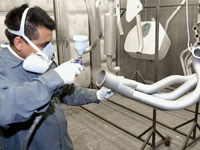Ceramic Coating helps to improve the moving metal parts

There are ample assortments of Ceramic coatings that can be used to metal components in order to augment their efficient properties. Most ceramic coatings are electrically nonconductive (making them outstanding insulators), have a considerably advanced level of abrasion opposition than several metals, and are competent of retaining their reliability under sternly prominent temperatures, sometimes up to 4,500 degrees Fahrenheit. Wear-resistant ceramics, such as titanium nitride and chromium carbide, can be used to work steels and air-hardening device steels through chemical vapor deposition (CVD), which is one of the most widespread application techniques at present in apply.
Before using a ceramic coating, it is vital to make sure compatibility among the ceramic material and the metal surface. Many of this compatibility is up to on thermal growth assets, as having increase rates that vary too deeply can basis a coating to fracture when it is being chilled after application. Furthermore, a dispersion layer usually produces on the metal surface, and this can direct to a coating that is very smooth and soft or too fragile for the design specifications. Matching thermal properties will assist to put off heat checking and perk up opposition to wear and break.
Ceramic coatings are always utilized as barrier materials to improve the interface between stirring metal components, like as in the automotive industry. Though, they are also more and more being used to enhance certain manufacturing procedures, and show prospective for developing the effectiveness of some fabricating techniques.
Ceramic coatings are strong and have a maximum level of lubricity, but due to corrosion considered, they are mostly utilized in temperatures under 1,200 degrees (F). However, this enables them to be used to hot falsifying dies, which run at lower temperatures. Ceramic coating enhances the functional lifetime for these dies, let them to generate a higher number of components prior to wearing down. Ceramic materials, like magnesium zirconate and zirconia, showing a great level of rigidity, thermal resistance, and lofty melting points are being employed as heat barrier coatings for industrial components.
Using a Ceramic coating to a substrate is various steps. The introductory stages of cleaning, toughening and undercoating (or priming) significantly control the hit of the project. The definite coating efficiency depends mostly on the mechanical, chemical, and physical links that resolve the coating stickiness and provide complete as well as greatest power and strength of the ceramic layer process.









